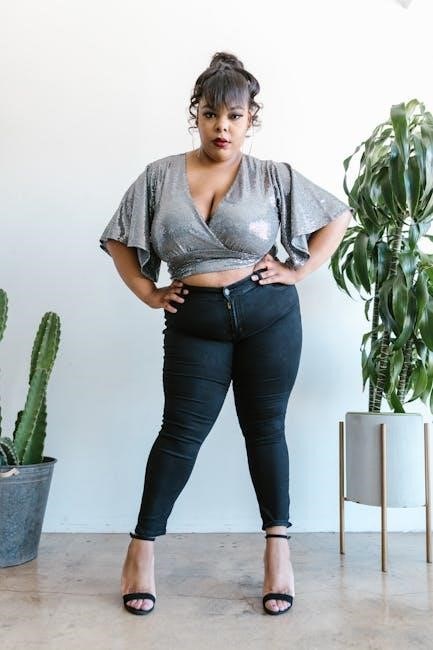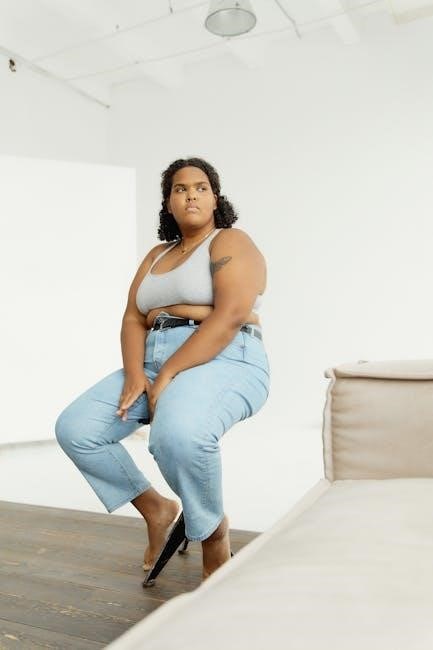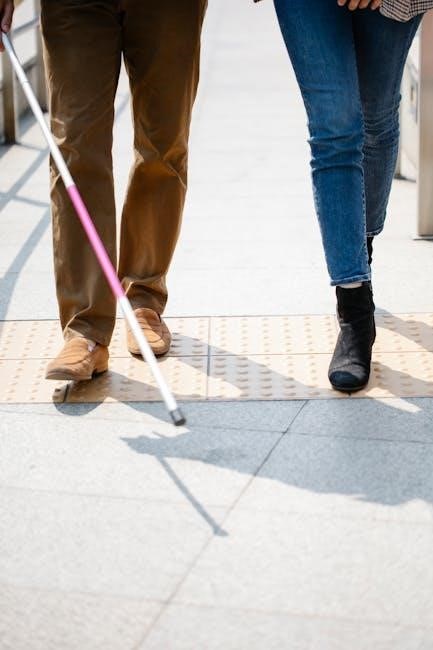jeans size guide
Discover the perfect fit with our comprehensive jeans size guide, helping you navigate measurements, styles, and sizes to ensure comfort and confidence in your denim choice․
Why Understanding Jeans Sizes is Important
Understanding jeans sizes is crucial for ensuring a perfect fit, which directly impacts comfort and style․ Incorrect sizing can lead to discomfort, unflattering silhouettes, and a lack of confidence․ With varying measurements across brands, knowing your precise waist, hip, and inseam measurements helps avoid guesswork․ Accurate sizing ensures jeans sit well, move freely, and enhance your body shape․ Whether you’re shopping slim-fit, relaxed, or plus-size styles, proper sizing guarantees a flattering and functional fit․ Investing time in measuring and understanding size charts empowers you to make informed purchases, saving time and reducing the hassle of returns․ A well-fitting pair of jeans is more than clothing; it’s a foundation for your wardrobe and personal style․
Key Factors Influencing Jeans Size
Jeans sizes are influenced by several key factors, including waist, hip, and inseam measurements․ Your body shape and proportions play a significant role in determining the best fit․ For example, slim-fit jeans are designed for lean body types, while relaxed-fit styles accommodate broader builds․ The rise of the jeans, whether low, mid, or high-waisted, also impacts sizing․ Fabric stretch and style details, such as bootcut or flare, can alter how the jeans fit your legs and hips․ Additionally, sizing varies between brands, so comparing measurements across labels is essential․ Understanding these factors ensures a tailored fit that balances comfort and aesthetics, making your jeans a perfect match for your unique physique․

How to Measure Yourself for Jeans
Accurate measurements are essential for the perfect fit․ Measure your waist at the narrowest point, hips at the widest part, and inseam from crotch to ankle․ Use a flexible tape measure and stand upright for precise results․
Measuring Your Waist
To measure your waist for jeans, locate the narrowest part of your torso, typically just above your belly button․ Wrap a flexible tape measure horizontally around this area, ensuring it’s snug but not tight․ Stand up straight and relax your stomach to get an accurate reading․ The measurement should be in inches or centimeters, depending on your region․ For example, if your waist measures 32 inches, you’ll likely fit a 32-inch waist jean․ Keep the tape measure level and parallel to the floor to avoid any tilting, which could skew the measurement․ This step is crucial for determining your jean size accurately and ensuring a comfortable fit․
Measuring Your Hips
To measure your hips for jeans, stand up straight and locate the widest point of your hips, typically 7-9 inches (18-23 cm) below your waistline․ Wrap a flexible tape measure around this area, ensuring it’s level and parallel to the floor․ The tape should be snug but not tight, and your feet should be shoulder-width apart․ This measurement helps determine your hip size, which, along with your waist, is essential for finding the perfect jean fit․ Keep the tape measure horizontal and avoid slouching to ensure accuracy․ This step is vital for selecting jeans that complement your body shape and provide comfort throughout the day․ Accurate hip measurements ensure the best fit for your chosen style․
Measuring Your Inseam
To measure your inseam, stand straight and place the tape measure along the inside of your leg, starting from the crotch seam down to your ankle bone․ Ensure the tape is taut but not tight, and keep your leg slightly bent for an accurate reading․ This measurement determines the length of your jeans, ensuring they fit perfectly without dragging on the ground or being too short․ For the best results, measure along the inner seam of your best-fitting pants as a reference․ Accurate inseam measurement is crucial for achieving the desired style, whether it’s slim-fit, bootcut, or relaxed․ This step ensures your jeans are proportional to your body and meet your personal style preferences․
Understanding Body Shape and Fit
Understanding your body shape is crucial for selecting jeans that flatter your figure․ Common body types include pear-shaped, rectangular, hourglass, and inverted triangle․ Pear-shaped individuals have narrower waists and wider hips, while hourglass figures have balanced proportions․ Rectangular body types have consistent measurements, and inverted triangles have broader shoulders and slimmer legs․ Jeans styles like slim-fit, bootcut, and flare cater to these shapes differently․ For example, bootcut jeans balance pear-shaped bodies, while slim-fit jeans complement rectangular frames․ High-waisted styles can enhance hourglass figures, and straight-leg jeans suit inverted triangles․ Matching your body shape to the right fit ensures both comfort and a polished look, making your denim choice more personalized and stylish․

Mens Jeans Size Guide
Find your perfect fit with accurate waist and hip measurements․ Jeans styles like slim-fit, relaxed, and bootcut cater to different body types, ensuring comfort and a stylish look․
Mens Jeans Size Chart: Waist and Hip Measurements
Accurate measurements are key to finding the perfect fit․ Mens jeans sizes are typically based on waist and hip measurements; Measure your waist at the narrowest point above your belly button and your hips at the widest part, usually 7-9 inches below your waistline․
A size chart might look like this: Waist 28 inches corresponds to US size 28, EU 44, and UK W28․ Hips measuring 36 inches align with a slim-fit style․ Larger waists, such as 34 inches, may fall into a relaxed or bootcut category․ Always check the specific brand’s sizing guide, as measurements can vary slightly․
Use this chart to match your measurements to the ideal size, ensuring comfort and style․ For international sizes, consult a conversion chart to find your equivalent size․ Remember, fit preferences like slim or relaxed can affect your choice․
How to Choose the Right Fit for Mens Jeans
Choosing the right fit for men’s jeans involves understanding your body shape and personal style preferences․ Measure your waist and hips accurately to determine your size from the chart․ Consider your lifestyle—slim-fit jeans are ideal for a tailored look, while relaxed or bootcut styles offer more comfort for casual wear․
Pay attention to rise options: low-rise for a trendy vibe or high-waisted for better support․ Fabric stretch is another factor; stretch denim provides flexibility, while rigid denim offers a classic feel․ Try jeans on if possible, as fit can vary between brands․ Ensure the jeans sit comfortably without restricting movement or sagging excessively․ Your fit should balance style and comfort, reflecting your unique needs and preferences․
Understanding Mens Jeans Styles: Slim-Fit, Relaxed, and Bootcut
Mens jeans come in various styles to suit different body types and preferences․ Slim-fit jeans are tailored closely to the legs, offering a modern, streamlined look․ They are ideal for slimmer builds or those who prefer a fashionable, fitted appearance․ Relaxed-fit jeans provide more room in the thigh and seat, making them comfortable for everyday wear, especially for men with larger or more muscular builds․ Bootcut jeans are slightly wider from the knee down, creating a balanced fit that works well with boots․ Each style caters to specific needs, ensuring comfort and style․ Understanding these options helps in selecting the perfect pair to match your lifestyle and body shape․

Womens Jeans Size Guide
Find your perfect fit with our women’s jeans size guide, offering precise waist, hip, and inseam measurements to ensure comfort and confidence in your denim choice․
Womens Jeans Size Chart: Waist and Hip Measurements
A women’s jeans size chart typically provides measurements for waist and hip sizes to help determine the best fit․ Sizes are often based on numeric or letter designations, with waist measurements ranging from 24 to 40 inches and hip measurements from 34 to 50 inches․ For example, a size 4 corresponds to a waist of 26-27 inches and hips of 35-36 inches, while a size 12 fits waists of 32-33 inches and hips of 42-43 inches․ The chart may also include inseam lengths for different styles․ Accurate measurements ensure comfort and confidence, as jeans are designed to fit specific body types and preferences․
How to Choose the Right Fit for Womens Jeans
Choosing the right fit for women’s jeans involves considering your body type, measurements, and personal style․ Start by measuring your waist and hips accurately to align with size charts․ Consider your body shape—whether you’re petite, curvy, or athletic—to select styles that flatter your figure; Skinny jeans are ideal for slender frames, while flare or bootcut styles balance curvier silhouettes․ High-waisted jeans can elongate torsos and provide support․ Ensure the jeans sit comfortably at the waist without gaping or feeling too tight․ Try jeans on if possible, as fit can vary between brands․ Pay attention to inseam lengths and rises to match your lifestyle and preferences․ The right fit should feel comfortable and boost confidence, making it essential to prioritize both style and comfort․
Understanding Womens Jeans Styles: Skinny, Straight, and Flare
Women’s jeans come in various styles, each catering to different body types and preferences․ Skinny jeans are tight-fitting, hugging the legs from waist to ankle, ideal for showcasing curves and pairing with boots or heels․ Straight jeans offer a classic fit with a consistent width from thigh to hem, providing a balanced look that suits most body types․ Flare jeans widen from the knee, creating a retro vibe and balancing proportions for curvier figures․ Each style offers versatility, allowing women to choose based on their lifestyle, body shape, and personal taste․ Whether for casual outings or formal events, these styles ensure a flattering and comfortable fit for every occasion․

Jeans Fits and Styles
Jeans come in diverse fits and styles, from slim-fit to relaxed, bootcut, high-waisted, and low-rise, catering to various body types, preferences, and occasions for ultimate comfort and flair․
Slim-Fit Jeans: Features and Benefits
Slim-fit jeans are designed to hug your legs tightly from thigh to ankle, offering a modern, streamlined look․ They are ideal for those seeking a fashionable yet comfortable fit․ These jeans are versatile and suit various body types, especially lean or athletic builds․ The slim fit enhances muscle definition and creates a stylish appearance․ They are perfect for casual outings or dressing up for special occasions․ The design often features slightly stretchy fabrics for ease of movement․ Pair slim-fit jeans with fitted tops for a cohesive look or with loose shirts for a relaxed vibe․ Their tapering silhouette ensures a polished, put-together look, making them a wardrobe staple for many․ Comfort and style blend seamlessly in slim-fit jeans, making them a popular choice for everyday wear․
Relaxed-Fit Jeans: Features and Benefits
Relaxed-fit jeans offer a loose, comfortable fit through the thigh and leg, making them perfect for casual outings or everyday wear․ They feature a roomier design compared to slim-fit styles, providing exceptional comfort and flexibility․ These jeans are ideal for those who prefer a laid-back, effortless look․ With their spacious cut, they suit a variety of body types, including muscular or taller individuals․ Relaxed-fit jeans often come in dark washes for a sleek appearance or light washes with distressed details for a trendy vibe․ They pair well with oversized shirts or graphic tees for a relaxed ensemble․ The loose silhouette ensures breathability and ease of movement, making them a great choice for all-day comfort without compromising on style;
Bootcut Jeans: Features and Benefits
Bootcut jeans are characterized by their wider leg opening, designed to fit comfortably over boots, and a straight cut through the thigh․ This style is both functional and fashionable, offering a classic look that suits various body types․ The wider leg creates a balanced silhouette, particularly flattering for those with a pear-shaped figure․ Bootcut jeans are versatile, pairing well with casual tops for a relaxed vibe or dressed up for a more polished appearance․ They provide ample comfort due to their roomy design and are ideal for active individuals․ The flared hem adds a stylish touch, making them a timeless choice for everyday wear or special occasions․ Their practicality and aesthetic appeal make bootcut jeans a popular option for many denim enthusiasts․
High-Waisted Jeans: Features and Benefits
High-waisted jeans are a popular choice due to their comfort and flattering design․ They sit above the natural waistline, offering a retro aesthetic while providing additional coverage and support․ This style is ideal for elongating the torso and creating a balanced silhouette․ High-waisted jeans are versatile, pairing well with tucked-in tops for a polished look or left untucked for a casual vibe․ They are particularly beneficial for those seeking to accentuate their curves or conceal the midsection; The higher rise also prevents gaping at the waist, ensuring a secure fit․ Whether dressed up or down, high-waisted jeans are a timeless option that combines style, comfort, and practicality, making them a wardrobe staple for many․ Their classic appeal ensures they remain a favorite across various fashion trends․
Low-Rise Jeans: Features and Benefits
Low-rise jeans are characterized by their lower waistline, sitting below the natural waist, offering a trendy and modern look․ They are known for their comfort and versatility, making them a favorite for casual outings and stylish ensembles․ One of the key benefits of low-rise jeans is their ability to elongate the legs, creating a balanced proportions․ They are available in various styles, from skinny to flare, catering to different body types and preferences․ Additionally, low-rise jeans provide a fashionable way to showcase belts or waist accessories, adding a personal touch to outfits․ Their relaxed fit around the hips and waist ensures ease of movement, making them ideal for everyday wear․ Whether paired with crop tops or longer shirts, low-rise jeans offer a chic and contemporary aesthetic that appeals to many fashion enthusiasts․

International Jeans Size Conversion
Understand how jeans sizes differ across regions, with US, EU, UK, and Russian sizes varying significantly․ This guide helps you match your size globally for a perfect fit․
US to EU Jeans Size Conversion
Understanding the differences between US and EU jeans sizes is crucial for international shoppers․ US sizes typically refer to waist measurements in inches, while EU sizes follow a numerical system․ For example, a US size 30 corresponds to an EU size 46․ This conversion isn’t uniform across all brands, as some may vary slightly․ To ensure accuracy, always consult a brand’s specific size chart․ Additionally, consider the fit style, as both regions offer options like slim-fit, relaxed, or bootcut․ By comparing measurements and styles, you can find the perfect fit whether shopping in the US or EU․ Always double-check the size conversion chart for the best results․
UK to US Jeans Size Conversion
Converting UK to US jeans sizes requires understanding the differences in their sizing systems․ UK sizes are often numerical, while US sizes are based on waist measurements in inches․ For example, a UK size W28 corresponds to a US size 28․ However, variations exist between brands, so it’s essential to refer to specific size charts․ Generally, UK sizes align closely with US measurements, but some brands may differ slightly․ When shopping across regions, consider both the size conversion and the fit style, as both UK and US markets offer similar options like slim-fit, relaxed, or bootcut․ Always check the brand’s size guide to ensure the best fit and avoid sizing discrepancies․
How to Use Size Conversion Charts Effectively
Using size conversion charts effectively involves more than just matching numbers; it requires understanding the nuances of different sizing systems and how they apply to your body․ Start by measuring yourself accurately, focusing on key areas like waist, hips, and inseam․ Compare these measurements to the charts provided by brands or retailers․ Pay attention to the specific fit styles, as terms like “slim-fit” or “relaxed” can vary between regions․ Double-check the brand’s size guide, as some may run smaller or larger than standard measurements․ Consider factors like fabric stretch and personal comfort preferences when selecting a size․ Finally, don’t hesitate to contact customer service for clarification if you’re unsure, ensuring the best possible fit for your jeans․

Plus-Size Jeans Guide
Find stylish, comfortable plus-size jeans that flatter your curves and allow freedom of movement, with top brands offering a variety of fits to suit every body type․
How to Find the Best Plus-Size Jeans for Your Body Type
Finding the best plus-size jeans involves understanding your body type and selecting styles that complement your shape․ For pear-shaped bodies, opt for bootcut or flare jeans to balance hips and thighs․ Hourglass figures look great in high-waisted styles that cinch the waist․ Apple-shaped individuals should try straight-leg or relaxed-fit jeans to draw attention away from the midsection․ Measure your waist, hips, and inseam to ensure accuracy․ Look for brands offering inclusive sizing, such as ASOS, Universal Standard, or Eloquii, which cater to diverse body types․ Consider fabric stretch for comfort and mobility․ Pairing the right fit with your body type ensures a flattering, confident look․ Explore different rises and washes to enhance your silhouette further․
Top Brands Offering Plus-Size Jeans
Several brands excel in offering stylish and well-fitting plus-size jeans․ ASOS Curve provides trendy options with inclusive sizing, while Universal Standard focuses on minimalist designs with premium fabrics․ Eloquii is known for its fashionable and affordable plus-size denim, offering a wide range of styles․ Lane Bryant and Torrid cater to curvier figures with trendy and comfortable designs․ Good American, founded by Emma Grede and Khloé Kardashian, offers a diverse size range and innovative fits․ Madewell and Levi’s also include plus-size options, ensuring high-quality denim for all body types․ These brands prioritize both style and comfort, making it easier for plus-size shoppers to find their perfect pair of jeans․
Measuring for Plus-Size Jeans: Tips and Tricks
Accurate measurements are key to finding the perfect plus-size jeans․ Use a flexible tape measure to determine your waist size by wrapping it around the narrowest part of your torso, just above your belly button․ For hip measurements, measure around the widest point of your hips, typically 7-9 inches below your waistline․ Ensure the tape is parallel to the floor and not too tight․ Consider your inseam by measuring from the crotch to your ankle for the ideal pant length․ Try jeans on in the afternoon, as bodies tend to swell slightly throughout the day․ Use size charts from brands like ASOS Curve or Universal Standard to match your measurements and find your best fit․ This ensures comfort, confidence, and a flattering silhouette․

How to Choose the Right Jeans Size
Selecting the right jeans size involves measuring your waist and hips accurately, comparing to size charts, and considering the fit style to ensure comfort and proper fit․
Trying Jeans Before Buying: Why It Matters
Trying jeans before buying is crucial for ensuring the best fit and comfort․ Sizing can vary significantly between brands and styles, and what fits one brand may not fit another․ Fabric stretch, denim thickness, and design details like rise and inseam length can affect how jeans feel․ Many brands offer sizing guides, but actual fit may differ due to these factors․ Trying jeans allows you to assess how they sit on your body, ensuring they are neither too tight nor too loose․ This step is especially important for plus-size individuals, as finding a flattering and comfortable pair can be challenging․ By trying jeans, you can confirm the quality, style, and overall satisfaction, making your purchase more confident and enjoyable․

How to Read Jeans Size Labels
Understanding jeans size labels is essential for selecting the right fit․ Most labels feature a numerical size, which typically represents the waist measurement in inches․ Some labels may also include hip measurements or a combination of both․ Letters like “S,” “M,” or “L” indicate standard sizes, while terms like “Slim Fit” or “Relaxed” describe the style․ Numeric sizing varies by brand, so it’s important to refer to the specific size chart provided by the manufacturer; Pay attention to details like inseam length, rise height, and fabric stretch, as these can impact fit․ Always check the label for care instructions and fabric composition to ensure durability and comfort․ Reading labels carefully helps you make informed decisions and find jeans that match your needs and preferences․

Common Mistakes When Buying Jeans
Common mistakes include relying solely on size numbers, which can vary between brands, and not considering the style and fit, impacting comfort and appearance․
Reliance on Size Numbers Alone
Relying solely on size numbers can lead to poor fits, as sizes vary significantly between brands and styles․ Many brands have inconsistent sizing, with differences in measurements even within the same label․ For example, a size 30 in one brand might fit differently than a size 30 in another․ Additionally, styles like slim-fit or relaxed cut can alter how jeans fit, even if the size number remains the same․ Body shape and proportions also play a role, making it essential to consider factors beyond just the number․ Always measure your waist and hips and try jeans on if possible to ensure the best fit․
Not Considering the Style and Fit
Ignoring the style and fit of jeans can lead to discomfort and an unflattering appearance․ Different styles, such as slim-fit, relaxed, or bootcut, cater to various body types and preferences․ Slim-fit jeans hug the legs tightly, while relaxed styles offer more room, and bootcut jeans flare slightly at the bottom․ Failing to consider these differences can result in jeans that are either too tight or unflattering․ Additionally, brands often have unique fits, so a style that works for one brand may not for another․ Always measure yourself and try jeans on if possible to ensure the best fit and comfort․ This approach helps you find jeans that align with your body shape and personal style, avoiding ill-fitting purchases․
Finding the perfect jeans fit involves accurate measurements, trying styles, and considering body shape․ Invest time to ensure comfort and confidence in your denim choice․
Final Tips for Finding the Perfect Jeans Fit
- Always try jeans on if possible, as sizes can vary between brands and styles․
- Consider the fabric—stretch denim offers more comfort and flexibility․
- Pay attention to rise height to ensure it complements your body type․
- Don’t rely solely on size numbers; focus on how they fit your body․
- Invest in quality denim for durability and a better fit over time․
- Style your jeans with confidence—accessories and shoes can enhance the look․

